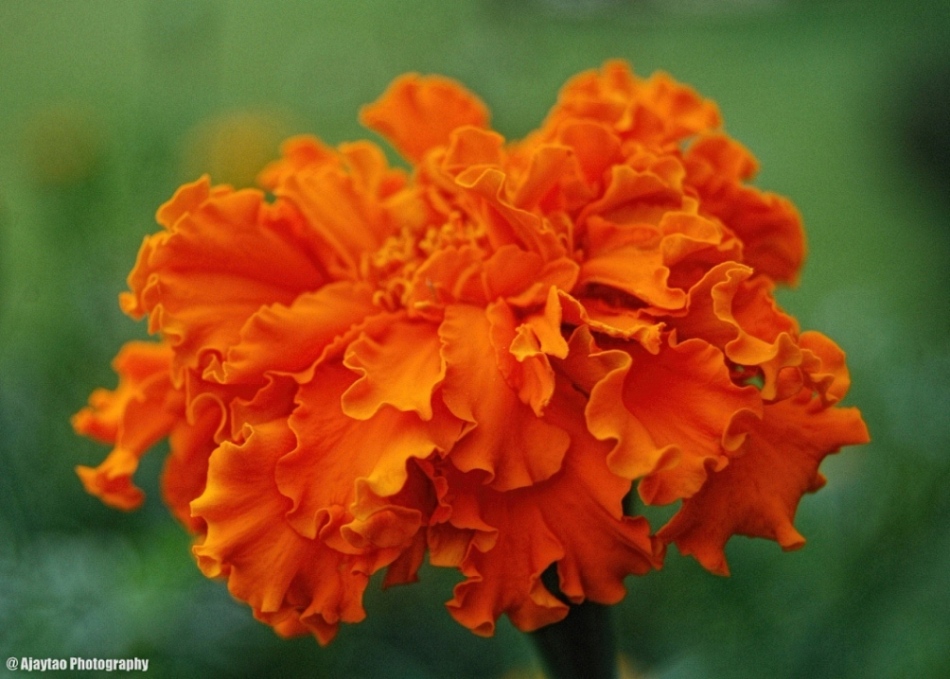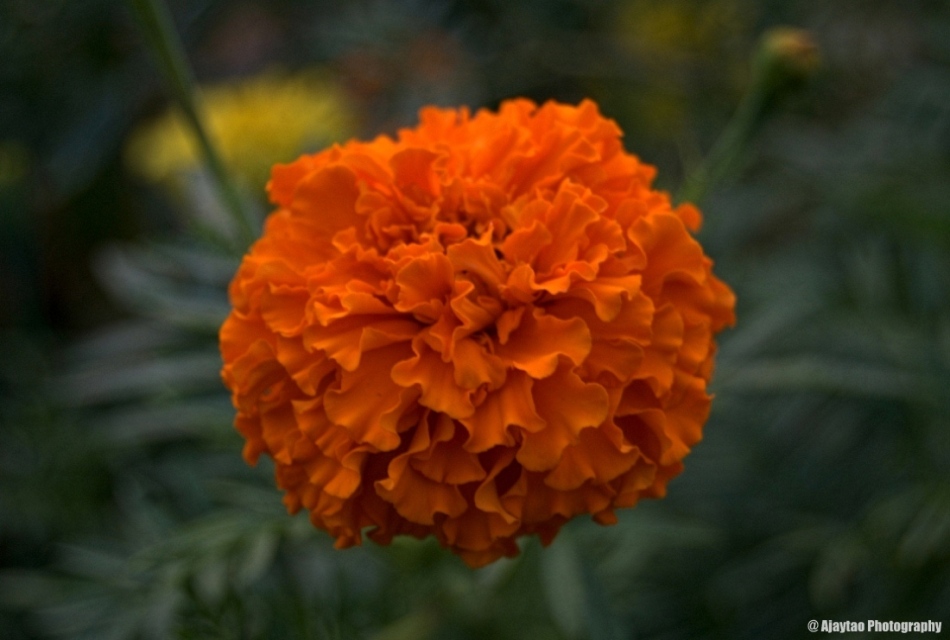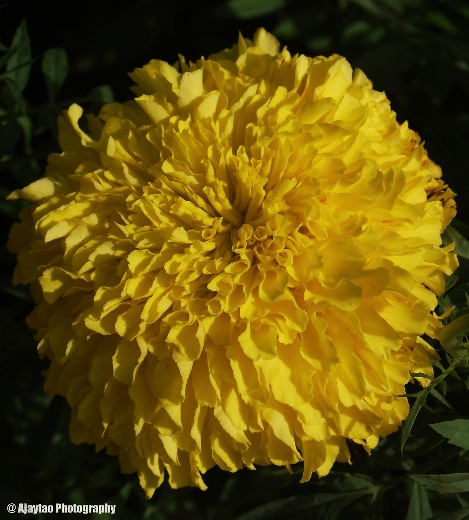Tagetes erecta – Marigold – Ajaytao
Common name: Marigold, African Marigold, Aztec Marigold, Chinchilla Enana, Huacatay, Mexican Marigold, Muster John Henry, Rose d’Inde, Saffron Marigold, Souci Africain, Souci
Hindi: Genda गेंदा ,
Marathi: Jhenduphool झेंडूफूल,
Botanical name: Tagetes erecta
Family: Asteraceae (Sunflower family)
Genus: Tagetes
Species: T. erecta
Tagetes is a genus of 56 species of annual and perennial, mostly herbaceous plants in the sunflower family (Asteraceae or Compositae).
The name Tagetes is from the name of the Etruscan Tages.
The common name in English, “marigold”, is derived from “Mary’s gold”, a name first applied to a similar plant native to Europe, Calendula officinalis.
The most commonly cultivated varieties of Tagetes are known variously as Mexican marigolds or African marigolds (usually referring to cultivars and hybrids of Tagetes erecta, although this species is not native to Africa), or French marigolds (usually referring to hybrids and cultivars of Tagetes patula, many of which were developed in France, although the species is not native to that country). Signet marigolds are hybrids derived mostly from Tagetes tenuifolia.
Tagetes minuta is the source of commercial “Tagetes oil” used in industry. It is now a naturalized species in Africa, Hawaii, and Australia, and is considered an invasive species (weed) in some regions. Tagetes minuta, native to southern South America, is a tall, upright marigold plant with small flowers used as a culinary herb in Peru, Ecuador, and parts of Chile and Bolivia, where it is called by the Incan term huacatay. The paste is used to make the popular potato dish called ocopa. Having both “green” and “yellow/orange” notes, the taste and odor of fresh T. minuta is like a mixture of sweet basil, tarragon, mint and citrus. It is also used as a medicinal tea in some areas., but some species have become naturalized around the world. One species, T. minuta, is considered a noxious invasive plant in some areas. They can be easily cultivated, are widely adaptable to varying soils and climatic conditions and have a good flowering duration. This bushy plant with around 20 to 30 species, have a long flowering period and the colours range from orange, yellow, gold, cream to apricot.
The species Tagetes lucida, known as pericón, is used to prepare a sweetish, anise-flavored medicinal tea in Mexico. It is also used as a culinary herb in many warm climates, as a substitute for tarragon, and offered in the nursery as “Texas tarragon” or “Mexican mint marigold“.
Depending on the species, marigold foliage has a musky, pungent scent, though some varieties have been bred to be scentless. It is said to deter some common insect pests, as well as nematodes. Tagetes species are hence often used in companion planting for tomato, eggplant, chili pepper, tobacco, and potato. Due to antibacterial thiophenes exuded by the roots, Tagetes should not be planted near any legume crop. Some of the perennial species are deer-, rabbit-, rodent- and javalina or peccary-resistant.
The marigold is very significant in Nepalese culture, where marigold garlands are used almost in every household, especially during the Tihar festival. It is always sold in the markets for daily worships and rituals.
The marigold was regarded as the flower of the dead in pre-Hispanic Mexico, parallel to the lily in Europe, and is still widely used in the Day of the Dead celebrations. The marigold is also widely cultivated in India and Thailand, particularly the species T. erecta, T. patula, and T. tenuifolia. Vast quantities of marigolds are used in garlands and decoration for weddings, festivals, and religious events. Marigold cultivation is extensively seen in Andhra Pradesh, Tamil Nadu, West Bengal, Karnataka, and Uttar Pradesh.
Marigolds have long had an important spiritual and religious significance for many different cultures. The Aztecs believed marigolds to have protective properties and could be of aid when foraging rivers or assist with healing after being struck by lightning. In India garlands made of Marigolds are used to honor gods in Hindu ceremonies. In Mexico Marigolds are steeped to make teas for rituals and for medicinal purposes, they are also used ornamentally on Dia de los Muertos to decorate alters created to honor past loved ones.
Marigolds are recorded as a food plant for some Lepidoptera caterpillars including the dot moth, and a nectar source for other butterflies. They are often part of butterfly gardening plantings. In the wild, many species are pollinated by beetle.
The marigold was regarded as the flower of the dead in pre-Hispanic Mexico, parallel to the lily in Europe, and is still widely used in the Day of the Dead celebrations.
In the Ukraine, chornobryvtsi (T. erecta, T. patula, and the signet marigold, T. tenuifolia) are regarded as one of the national symbols, and are often mentioned in songs, poems, and tales.
The vivid orange color of Marigold flowers makes them ideal for use as décor on wedding cakes and other pastries prepared for celebratory occasions. Use as garnish when plating or on serving platters. Float atop a punch bowl of red or white sangria. Their appearance will complement spring, summer and early fall preparations best. The florets of Tagetes erecta are rich in the orange-yellow carotenoid lutein and are used as a food colour (INS-number E161b) in the European Union for foods such as pasta, vegetable oil, margarine, mayonnaise, salad dressing, baked goods, confectionery, dairy products, ice cream, yogurt, citrus juice and mustard. In the United States, however, the powders and extracts are only approved as colorants in poultry feed.
Medicinal Uses
Tagetes is a plant. The parts that grow above the ground are used to make medicine.
Tagetes is used for digestive tract problems including poor appetite, gas, stomach pain, colic, intestinal worms, and dysentery. It is also used for coughs, colds, mumps, fluid retention, and sore eyes; and causing sweating.
Women use tagetes to start menstruation, treat sore breasts (mastitis), and protect against miscarriage.
People sometimes apply the Leaves directly to the skin for treating sores and ulcers. The Flowers are used as a mosquito repellent. The Juice of the leaves is put on the skin for treating eczema. The Oil is put on the skin for treating wound maggots.
In foods and beverages, tagetes is used as a flavor component.
In manufacturing, the oil is used as a fragrance in perfumes. The dried, ground flowers are used as chicken feed to enhance the characteristic yellow color of chicken skin and egg yolk.
Tagetes contains ingredients that might help decrease swelling (inflammation) and spasms, calm the nerves, and reduce blood pressure.
Ajaytao Photography






Marigolds we have in our garden… Beautiful flowers
LikeLiked by 1 person
May 12, 2014 at 9:34 pm
yes yes I love them they are so sacred 🙂
thank you so much 🙂
LikeLike
May 12, 2014 at 9:37 pm
Beautiful! 🙂
LikeLiked by 1 person
May 12, 2014 at 10:01 pm
Thank you dear 🙂
LikeLike
May 12, 2014 at 10:33 pm
The petals look so fragile, yet so vibrant….just beautiful. 🙂
LikeLiked by 1 person
May 12, 2014 at 11:29 pm
Thank you so much dear 🙂
LikeLike
May 12, 2014 at 11:30 pm
The yellow one, I use to have it in my little garden… 🙂
LikeLike
May 13, 2014 at 12:19 am
Oh dear George so beautiful 🙂
thanks 🙂
LikeLike
May 13, 2014 at 12:35 am
A marigold never looked so beautiful!
LikeLiked by 1 person
May 13, 2014 at 12:26 am
oh thank you dear 🙂
LikeLike
May 13, 2014 at 12:33 am
Good view of the stamens on the first image. These Marigolds usually hide their stamens until the very end.
LikeLiked by 1 person
May 14, 2014 at 5:08 pm
oh yes they do hide them 🙂
thank you so much dear Maria 🙂
LikeLike
May 14, 2014 at 5:10 pm
Reblogged this on Ajaytao 2010 and commented:
Tagetes erecta – Marigold – Ajaytao
LikeLike
May 20, 2014 at 11:41 am
Beautiful and excellent background!
LikeLiked by 1 person
May 20, 2014 at 9:23 pm
Oh thank you so much dear Bo 🙂
I feel honored by your comments
thanks 🙂
LikeLike
May 20, 2014 at 10:10 pm